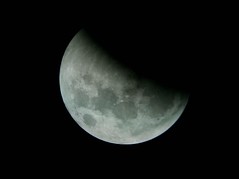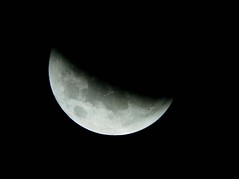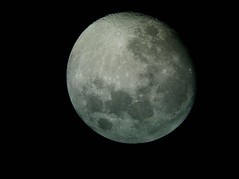


This is a big event so I had prepared for it. I had the exact times for my location from CalSky.com, camera set up with my 25mm eyepiece and lunar filters attached to my 40mm and 15mm eyepieces. The telescope was set up on the roof of my house (we have flat roofs here) and had the laptop in nearby room. My browser was set on the Greenwich exact time, the direct webcast from the Mira Observatory in Belgium and another two webcasts which unfortunately must have been swamped by hits and were unavailable. I also had my 16X50 binoculars at hand. The weather was good except for some dispersed cirrus clouds initially and an ever strengthening wind.
The moon entered penumbra at 21:18 (times are local i.e. CET, UTC +1). At first not much was visible but eventually a dusky patch could be seen in the Mare Nubium / Oceanus Procellarum area. This increased in size until at 22:30:01 the partial phase commenced as the Moon entered the Earth’s umbra. A progressively larger bite was taken out of the Moon. Details in the shaded area could sill be observed with the telescope. I managed to take some photos of this and three of them may be seen above. I posted two of these on flickr.com almost in real time. As the shadow increased in size, it started taking on the characteristic reddish brown or coppery tinge.
Totality started at 23:43:46. The moon was now of a deep copper colour with a lighter rim, especially the North East area North of the Mare Crisium which was the last to go into shadow. Totality brings some interesting observations. The sky was dark almost as in the New Moon phase. The fainter stars became visible. The image of an orange ball suspended below the lion was unusual. At eclipse maximum at 00:20:52 I could even see the M44 with the naked eye. Another interesting effect is that the stars very close to the moon are observable with the telescope. From my position, for example, star TYC 0261 00664-1 Mag 10.19 was only 22 arcseconds South West of the Moon and the motion of the moon against the star was discernable. Unfortunately my small camera was not sensitive enough to photograph totality. Totality ended at 00:57:58.
I tried to place the intensity of the eclipse on the Danjon scale. I am not experienced at this and found it difficult. I personally don’t believe it was very intense. The lunar surface features were visible even with the naked eye. I would say it was closest to L3 but I stand to be corrected.
It then got too windy for the scope and continued following the event visually until 2:08 when only a small shadow was left in the Mare Smithii area. The Moon was about to leave the umbra at 2:11:42.
Larger versions of my photos are on my Flickr site





